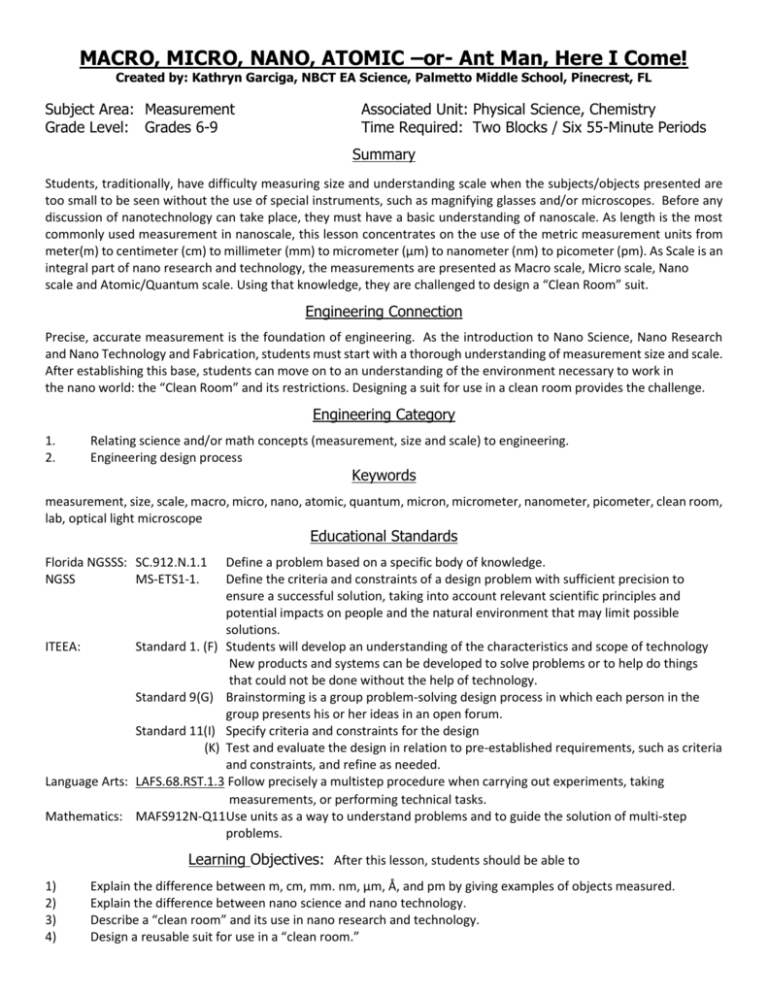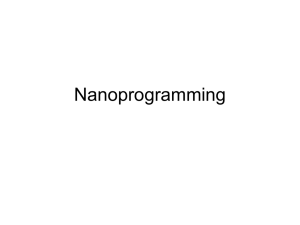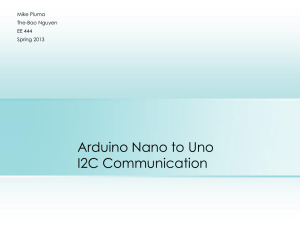MACRO, MICRO, NANO, ATOMIC –or
advertisement

MACRO, MICRO, NANO, ATOMIC –or- Ant Man, Here I Come! Created by: Kathryn Garciga, NBCT EA Science, Palmetto Middle School, Pinecrest, FL Subject Area: Measurement Grade Level: Grades 6-9 Associated Unit: Physical Science, Chemistry Time Required: Two Blocks / Six 55-Minute Periods Summary Students, traditionally, have difficulty measuring size and understanding scale when the subjects/objects presented are too small to be seen without the use of special instruments, such as magnifying glasses and/or microscopes. Before any discussion of nanotechnology can take place, they must have a basic understanding of nanoscale. As length is the most commonly used measurement in nanoscale, this lesson concentrates on the use of the metric measurement units from meter(m) to centimeter (cm) to millimeter (mm) to micrometer (µm) to nanometer (nm) to picometer (pm). As Scale is an integral part of nano research and technology, the measurements are presented as Macro scale, Micro scale, Nano scale and Atomic/Quantum scale. Using that knowledge, they are challenged to design a “Clean Room” suit. Engineering Connection Precise, accurate measurement is the foundation of engineering. As the introduction to Nano Science, Nano Research and Nano Technology and Fabrication, students must start with a thorough understanding of measurement size and scale. After establishing this base, students can move on to an understanding of the environment necessary to work in the nano world: the “Clean Room” and its restrictions. Designing a suit for use in a clean room provides the challenge. Engineering Category 1. 2. Relating science and/or math concepts (measurement, size and scale) to engineering. Engineering design process Keywords measurement, size, scale, macro, micro, nano, atomic, quantum, micron, micrometer, nanometer, picometer, clean room, lab, optical light microscope Educational Standards Florida NGSSS: SC.912.N.1.1 NGSS MS-ETS1-1. Define a problem based on a specific body of knowledge. Define the criteria and constraints of a design problem with sufficient precision to ensure a successful solution, taking into account relevant scientific principles and potential impacts on people and the natural environment that may limit possible solutions. ITEEA: Standard 1. (F) Students will develop an understanding of the characteristics and scope of technology New products and systems can be developed to solve problems or to help do things that could not be done without the help of technology. Standard 9(G) Brainstorming is a group problem-solving design process in which each person in the group presents his or her ideas in an open forum. Standard 11(I) Specify criteria and constraints for the design (K) Test and evaluate the design in relation to pre-established requirements, such as criteria and constraints, and refine as needed. Language Arts: LAFS.68.RST.1.3 Follow precisely a multistep procedure when carrying out experiments, taking measurements, or performing technical tasks. Mathematics: MAFS912N-Q11Use units as a way to understand problems and to guide the solution of multi-step problems. Learning Objectives: After this lesson, students should be able to 1) 2) 3) 4) Explain the difference between m, cm, mm. nm, µm, Å, and pm by giving examples of objects measured. Explain the difference between nano science and nano technology. Describe a “clean room” and its use in nano research and technology. Design a reusable suit for use in a “clean room.” Lesson Background and Concepts for Teachers As explained, this lesson familiarizes students with metric measurements used in nano research and technology. See the following Lab Sheet/Worksheet for all information. Basic knowledge of both the English and SI measurement systems, as well as, scientific notation is recommended. Students will need appropriate devices to access the Internet and the following lab supplies: microscopes, microscope slides, aniline dye, meter sticks, rulers, measuring tapes, tape. Again, see Worksheet. Introduction/Motivation The 2015 release of the movie Ant Man is proving to be quite popular with students. The movie deals with a comic book hero from the Avengers series who is able, through use of a specially designed suit, to shrink from a height of 183cm (6ft) to 1.25cm (.5in.) While Ant Man is clearly visible at his smallest, the micro, atomic and sub-atomic levels of objects are discussed in the film. Question the students about their understanding of these levels. Vocabulary/Definitions The following words are either defined in the Student Worksheet/Lab Sheet or the students are requested to find definitions for them. All definitions should be in words that a 3rd grade student could understand. It is preferable to discuss all definitions and arrive at ones that all agree are easily understood. Consequently, definitions are not provided in this document – they are a collaborative element between/among students and teacher. Macro, micro, nano, atomic/quantum, Angstrom, pico, nanoscience, nanotechnology, clean room, electron, optical light Associated Activities This lesson plan includes 1 “hands-on” activity, using a microscope and one engineering lab group activity, using garbage bags and duct tape to design a clean room suit. Assessment Successful completion of Lab/Worksheet: 3 grades Successful completion of Clean Room Suit design: 2 grades. Many teachers will add/include a 1 weighted grade for successful participation in activities. Lesson Extension Activites The 2013 PBS NOVA documentary Marking Stuff: Smaller, narrated by David Pogue, is an excellent follow-up/extension activity to both extend the lesson and increase student interest in pursuing these topics further. Contributors/Supporting Program The inspiration for this lesson plan came from the faculty and teacher colleague participation in the 2015 Florida International University College of Engineering and Computing Research for Experienced Teachers (RET) program, Dr. Masoud Milani, Director. Attachments This is the Student Worksheet/Lab Sheet for Measurement. Ant Man Here I Come!.docx This is the Student Engineering Lab Worksheet for Design a Clean Room Suit. Design a Clean Room Suit.docx This is the Teacher Verification Form for the Design a Clean Room Suit Lab. Design a Clean Room Suit Teacher Form.docx







